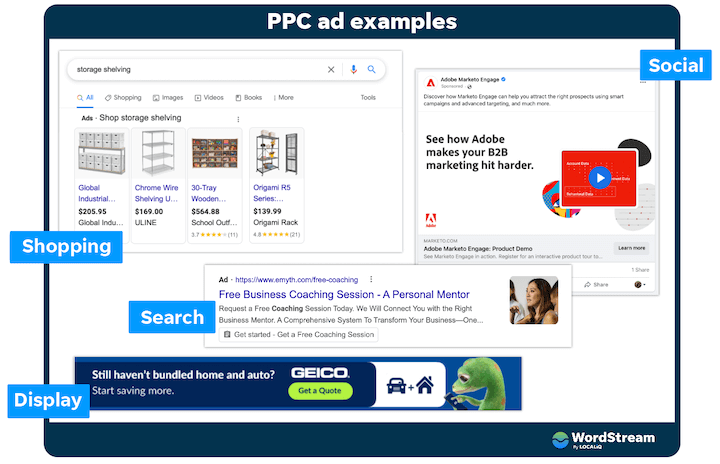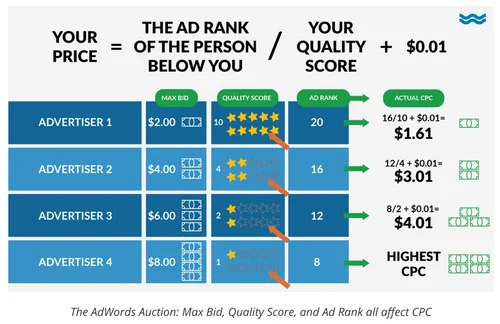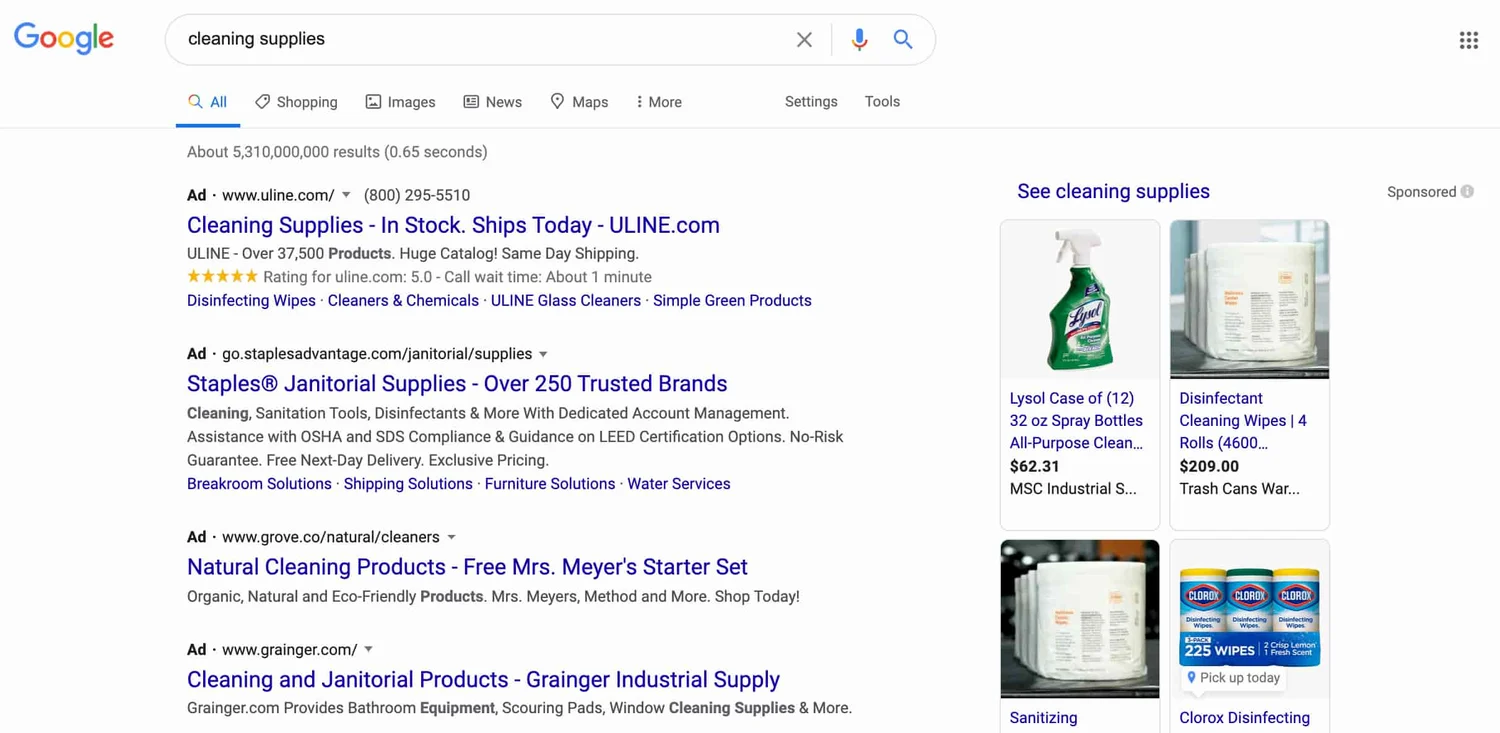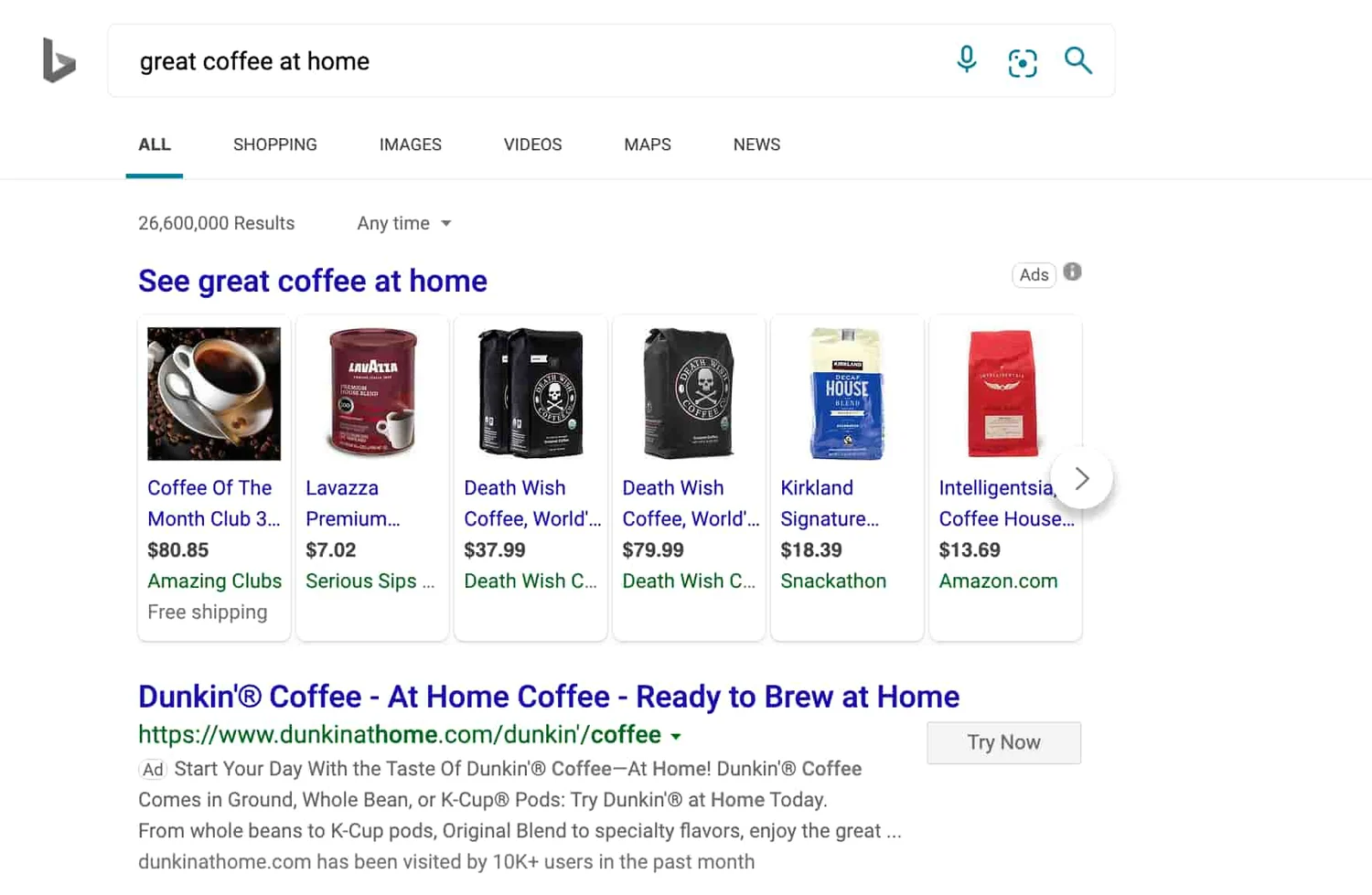|
Getting your Trinity Audio player ready...
|
Have you ever wondered how businesses manage to appear at the top of search engine results? It’s all thanks to PPC advertising. But what exactly is PPC advertising and how does it work?
In today’s digital age, online advertising has become an essential tool for businesses like yours to effectively reach your target audience. Pay-per-click (PPC) advertising is the game-changer that has revolutionized the way businesses promote their products and services online.
By understanding the basics of PPC advertising, you can gain a competitive edge in the online marketplace, whether you’re a business owner or a marketing professional.
In this article, we will take a deep dive into the world of PPC advertising. We’ll demystify what PPC advertising is, how it works, and the numerous benefits it can bring to your business.
So, get ready to unlock the power of PPC advertising and discover how it can propel your business to new heights of success.
PPC (Pay-per-click)
PPC stands for pay-per-click, a model of digital advertising where the advertiser pays a fee each time one of their ads is clicked.
What is PPC Advertising?
PPC advertising is a powerful digital marketing approach that allows you to display your ads across various online platforms, paying only when users click on them. It is an auction-based system where businesses bid on specific keywords relevant to their products or services.
When users search for these keywords, the ads appear on search engine results pages (SERPs) or other online platforms, making it a direct and targeted way to reach potential customers.
PPC advertising is not limited to search engines alone. It extends to social media platforms like Facebook, Instagram, and LinkedIn, as well as display networks where banner ads are showcased on relevant websites.
This versatility enables you to connect with your audience across different channels, meeting them wherever they spend their time online.
The main goal behind PPC advertising is to drive targeted traffic to your website or landing page, creating visibility, generating leads, and ultimately converting users into loyal customers. This strategy enables you to reach your specific target audience precisely when they are actively searching for products or services in your industry.

So, get ready to take your business to new heights with PPC advertising. Let’s dive deeper into the world of PPC and explore the key elements that make it a game-changer for your brand.
Key Elements of a Successful PPC Campaign
To create a successful PPC campaign that yields optimal results, it’s essential to focus on key elements that contribute to its effectiveness. By paying attention to these elements, you can maximize your campaign’s performance and achieve your desired outcomes.
Here are the key elements to consider:
1. Keyword research and selection
Thorough keyword research is the foundation of a successful PPC campaign. Identify relevant keywords that align with your business, products, or services.
Use keyword research tools to discover high-volume and low-competition keywords that will drive targeted traffic to your website. Incorporate a mix of broad, exact match, and long-tail keywords to reach a wider audience while maintaining relevance.
2. Ad creation and optimization
Crafting compelling and persuasive ad copy is crucial to capturing the attention of your target audience. Develop engaging headlines, clear and concise descriptions, and strong calls-to-action (CTAs).
Test multiple ad variations to identify which ones resonate best with your audience. Continuously optimize your ads by refining the messaging, testing different CTAs, and incorporating relevant keywords.
3. Landing page optimization
Your landing page plays a vital role in converting PPC traffic into leads or customers. Ensure that your landing page is well-designed, visually appealing, and aligned with your ad’s messaging.
Optimize it for a seamless user experience, with clear navigation, persuasive content, and prominent calls-to-action. Conduct A/B testing to determine the most effective layout, design, and elements that drive conversions.
4. Bid management and budgeting
Effective bid management is essential for controlling costs and achieving desired ad placements. Set appropriate bid amounts based on keyword competitiveness, audience targeting, and campaign goals.
Regularly monitor and adjust bids to optimize your campaign’s performance and maintain a balance between cost and ad position. Additionally, establish a budget that aligns with your overall marketing goals and adjust it as necessary to achieve optimal results.

By focusing on these key elements, you can create a strong foundation for your PPC campaign and increase its chances of success. Continuously monitor and optimize these elements based on performance data and industry trends to drive maximum ROI from your PPC advertising efforts.
Benefits of PPC Advertising
PPC advertising offers several key benefits that make it a powerful tool for businesses seeking to expand their online presence and drive results.
Here are some of the notable advantages of incorporating PPC into your digital marketing strategy:
1. Immediate and targeted visibility
PPC advertising provides instant visibility to your brand, allowing you to appear at the top of search results and reach your target audience when they are actively searching for relevant keywords. This immediate exposure helps drive qualified traffic to your website and increases the likelihood of conversions.
2. Cost-effective advertising
With PPC, you only pay when someone clicks on your ad, making it a cost-effective advertising method. You have control over your budget, allowing you to set daily or monthly limits to ensure you stay within your financial boundaries.
Additionally, the ability to target specific keywords, demographics, locations, and devices ensures that you reach the most relevant audience for your business.
3. Measurable and trackable results
PPC advertising platforms provide robust tracking and analytics tools that allow you to measure the performance of your campaigns accurately. You can track metrics such as clicks, impressions, conversions, and ROI, gaining valuable insights into the effectiveness of your advertising efforts.
This data-driven approach enables you to optimize your campaigns, identify areas for improvement, and make data-backed decisions to maximize your return on investment.
4. Flexibility and control over ad campaigns
PPC advertising gives you full control over your ad campaigns. You can create and customize ads based on your specific goals, target audience, and messaging.
Additionally, you can adjust your campaigns in real-time, modifying ad copy, adjusting bids, or pausing campaigns as needed. This flexibility allows you to respond quickly to market changes, optimize your campaigns for better performance, and achieve your desired outcomes.
By harnessing the benefits of PPC advertising, businesses can effectively reach their target audience, drive relevant traffic to their website, and achieve their marketing objectives. It is a valuable tool for increasing brand visibility, generating leads, and ultimately driving conversions.
PPC Advertising Platforms
To effectively implement your PPC campaigns, it’s crucial to understand the various advertising platforms available and choose the ones that align with your business objectives.
Here are some popular PPC advertising platforms to consider:
Google Ads (formerly known as Google AdWords)
With its extensive reach and dominance in the search engine market, Google Ads is a must-have platform for PPC advertising. It allows you to display ads on Google search results pages, partner websites, and Google-owned platforms like YouTube.
Leverage powerful targeting options, such as keywords, demographics, and geographic location, to reach your desired audience effectively.

Microsoft Advertising (formerly known as Bing Ads)
While Google Ads is the leader, Microsoft Advertising offers an alternative platform to reach a different user base. By running PPC campaigns on Bing search results pages, Yahoo, and AOL, you can tap into a significant portion of the search market.
Microsoft Advertising provides similar targeting options and features as Google Ads, allowing you to expand your reach and connect with a diverse audience.

Social media advertising platforms
Social media platforms like Facebook Ads, Instagram Ads, LinkedIn Ads, and Twitter Ads offer powerful PPC advertising opportunities.

These platforms provide extensive targeting options based on demographics, interests, behaviors, and connections, allowing you to reach highly specific audience segments. Leverage the visual nature of social media to create engaging ad formats that resonate with your target audience.
Other PPC advertising platforms and networks
Apart from the major platforms, there are several niche PPC advertising platforms and networks that cater to specific industries or audience segments.
Examples include Amazon Advertising for e-commerce businesses, Pinterest Ads for visual-centric marketing, and Quora Ads for targeting specific interest-based audiences. Assess your target audience and industry to determine if these platforms align with your marketing objectives.
By leveraging multiple platforms strategically, you can expand your reach, increase brand visibility, and drive qualified traffic to your website.
Types of PPC Advertising
PPC advertising offers various formats and approaches to reach your target audience effectively. Understanding the different types of PPC advertising can help you tailor your campaigns to specific goals and engage with users across different channels.
Here are the key types of PPC advertising:
1. Search Advertising
Search advertising is the most common type of PPC advertising. It involves bidding on keywords relevant to your business and displaying text ads on search engine results pages (SERPs) when users search for those keywords.
This type of advertising allows you to target users actively searching for products or services similar to what you offer, making it highly effective for driving qualified traffic and conversions.
2. Display Advertising
Display advertising involves placing visual banners or text ads on third-party websites, apps, or other digital platforms within an advertising network. These ads can be static or interactive, offering the opportunity to showcase your brand creatively.
Display ads can help increase brand visibility, generate awareness, and reach a broader audience beyond search engines.
3. Remarketing/Retargeting
Remarketing or retargeting allows you to target users who have previously interacted with your website or shown interest in your products or services. By placing a tracking pixel on your website, you can display targeted ads to these users as they browse other websites or platforms within the ad network.
Remarketing helps reinforce your brand message, re-engage potential customers, and increase conversion rates.
4. Shopping/Product Listing Ads
Shopping ads are specific to e-commerce businesses and allow you to showcase your products directly within search engine results. These ads feature product images, prices, and other relevant information, making it easier for users to compare and make purchasing decisions.
Shopping ads are highly effective for driving product-specific traffic and increasing online sales.
PPC Advertising Strategies
To make the most of your PPC advertising campaigns, it’s essential to develop effective strategies that align with your business goals and target audience.
Here are some key strategies to consider when planning and executing your PPC campaigns:
1. Setting Clear Campaign Goals and Objectives
Start by defining your campaign goals and objectives. Are you aiming to increase website traffic, generate leads, boost sales, or enhance brand awareness?
Clearly outlining your objectives will help shape your campaign structure, targeting, and messaging.
2. Targeting the Right Audience
PPC platforms offer extensive targeting options to ensure your ads reach the right audience. Take advantage of demographic targeting, location targeting, and other audience segmentation features to refine your targeting parameters and reach users who are most likely to convert.
3. Ad Scheduling and Budget Allocation
Analyze your campaign performance data to determine the most effective times and days to display your ads. By scheduling your ads during peak times or when your target audience is most active, you can maximize the impact of your campaigns.
Additionally, allocate your budget strategically, focusing on high-performing ads and adjusting bids to achieve optimal results.
4. Ad Testing and Optimization
A/B testing is crucial for optimizing your PPC ads. Experiment with different ad copy, headlines, calls-to-action, and visuals to identify what resonates best with your audience.
Continuously monitor and analyze your ad performance, making data-driven optimizations to improve click-through rates, conversion rates, and overall campaign performance.
Measuring and Analyzing PPC Campaign Performance
To gauge the success of your PPC campaigns and make data-driven decisions, it’s crucial to measure and analyze their performance.
Here are key aspects to consider when measuring and analyzing your PPC campaign performance:
1. Key Metrics and Performance Indicators
Pay attention to essential metrics that provide insights into your campaign’s effectiveness. Some key metrics include click-through rate (CTR), conversion rate, cost per click (CPC), cost per acquisition (CPA), and return on ad spend (ROAS).
These metrics help you understand the performance of your ads, keywords, and campaigns.
2. Tracking Conversions and ROI
Implement conversion tracking to measure the actions users take on your website after clicking on your ads. This could include purchases, form submissions, newsletter sign-ups, or any other desired actions.
Linking conversions to your PPC campaigns enables you to measure the return on investment (ROI) and make informed decisions about budget allocation and campaign optimizations.
3. Tools for PPC Campaign Analytics and Reporting
Take advantage of analytics tools provided by the PPC platforms themselves, such as Google Ads and Microsoft Advertising. These platforms offer robust reporting features that allow you to dive deep into your campaign data and generate customized reports.
Additionally, third-party tools like Google Analytics can provide comprehensive insights into the overall performance of your PPC campaigns and their impact on your website’s traffic and conversions.
PPC Advertising Best Practices
To maximize the effectiveness of your PPC advertising campaigns, it’s important to follow industry best practices. Implementing these strategies will help you optimize your ads, improve your click-through rates, and increase conversions.
Here are some PPC advertising best practices to consider:
Ad Copywriting Tips
Create compelling and relevant ad copy that grabs the attention of your target audience. Use persuasive language, highlight unique selling propositions, and include a clear call-to-action (CTA).
Incorporate relevant keywords in your ad copy to improve ad relevance and quality score.
Landing Page Optimization Techniques
Ensure that your landing pages align with your ad messaging and provide a seamless user experience. Optimize your landing pages for fast loading speed, mobile responsiveness, and clear navigation.
Use persuasive elements such as compelling headlines, persuasive content, and prominent CTAs to encourage conversions.
Ad Extensions and Ad Formats
Take advantage of ad extensions offered by PPC platforms to enhance your ad’s visibility and provide additional information. Use extensions like site links, call extensions, and structured snippets to provide more context and increase the chances of clicks.
Experiment with different ad formats, such as text ads, image ads, and video ads, to diversify your ad campaigns.
Remarketing Strategies
Implement remarketing campaigns to re-engage users who have previously interacted with your website or shown interest in your products or services. Create tailored ads specifically targeting these audiences, offering personalized messaging and incentives to encourage them to convert.
By following these best practices, you can improve the performance of your PPC advertising campaigns, increase click-through rates, and drive conversions.
Common PPC Advertising Mistakes to Avoid
While PPC advertising can be highly effective, it’s important to be aware of common mistakes that can hinder your campaign’s success. By avoiding these pitfalls, you can ensure that your PPC efforts yield optimal results.
Here are some common PPC advertising mistakes to watch out for:
Poor Keyword Selection
Choosing the wrong keywords or using broad-match keywords without proper research can result in irrelevant ad impressions and wasted ad spending. Conduct thorough keyword research to identify relevant, high-intent keywords that align with your campaign goals.
Irrelevant or Poorly Written Ads
Creating ads that lack relevance to the user’s search intent or are poorly written can lead to low click-through rates and poor ad performance. Craft compelling ad copy that communicates your value proposition and entices users to click.
Neglecting Landing Page Optimization
Even if your ads are effective, directing users to a poorly optimized landing page can lead to high bounce rates and low conversions. Ensure that your landing pages provide a seamless user experience, align with the ad messaging, and have clear and persuasive calls-to-action.
Lack of Ongoing Campaign Management and Optimization
PPC advertising requires continuous monitoring and optimization to ensure optimal performance. Neglecting to regularly review and refine your campaigns can result in wasted ad spend and missed opportunities for improvement.
Keep a close eye on your campaign metrics, make data-driven optimizations, and stay up-to-date with industry trends.
PPC Advertising and Your Brand Strategy
PPC advertising plays a crucial role in enhancing your brand strategy and overall marketing efforts. By aligning your PPC campaigns with your brand messaging and positioning, you can effectively reach your target audience, reinforce brand awareness, and drive conversions.
Here’s how PPC advertising can strengthen your brand strategy:
Aligning PPC Advertising with Your Brand Messaging and Positioning
Your PPC ads should reflect the unique value proposition of your brand and convey a consistent message across all touchpoints. Incorporate your brand voice, tone, and visual elements into your ad copy and design to create a cohesive brand experience for your audience.
Integrating PPC with Other Digital Marketing Channels
PPC advertising can complement other digital marketing channels such as SEO, social media marketing, and content marketing. By integrating PPC with these channels, you can create a synergistic effect and amplify your brand reach and impact.
Coordinate your messaging and strategies across different channels to ensure a unified brand presence.
Leveraging PPC to Drive Brand Awareness and Conversions
PPC advertising allows you to target specific keywords, demographics, and geographic locations, enabling you to reach your ideal audience precisely. Use PPC campaigns to increase brand visibility, generate leads, and drive conversions.
Use remarketing strategies to re-engage users who have previously interacted with your brand, reinforcing brand recall and encouraging conversions.
By leveraging PPC advertising as part of your brand strategy, you can establish a strong online presence, connect with your target audience, and achieve your marketing objectives. It provides you with a powerful tool to promote your brand, drive engagement, and maximize your business’s growth potential.
Build an Effective PPC Strategy
In conclusion, PPC advertising is an indispensable tool for businesses looking to enhance their online visibility, attract quality traffic, and drive conversions. As a business professional, understanding the fundamentals of PPC advertising and incorporating it into your digital marketing strategy can have a profound impact on your brand’s success.
Remember that PPC advertising is not a one-time effort but rather an ongoing process that requires monitoring, testing, and continuous improvement. Regularly analyzing campaign performance, adjusting bids, and refining ad content is essential to staying competitive in the ever-evolving digital landscape.
Integrating PPC advertising with your brand strategy can elevate your brand’s online presence, reinforce messaging, and align your marketing efforts cohesively. Whether you aim to boost brand awareness, drive website traffic, or increase sales, PPC advertising provides the versatility and control you need to accomplish your objectives.
Now that you are equipped with valuable insights into PPC advertising, leap and explore the vast opportunities it offers to enhance your brand’s growth. Embrace the power of data-driven advertising, and with diligent execution, your business can reach new heights in the digital realm.
At The Brand Shop, we understand the importance of PPC advertising in achieving your brand’s goals. Our team of digital marketing experts is here to assist you in developing and executing PPC campaigns that align seamlessly with your brand strategy.
Ready to take your digital marketing to the next level? Contact us at The Brand Shop to learn how we can help you develop and execute a successful PPC advertising strategy tailored to your business needs.
